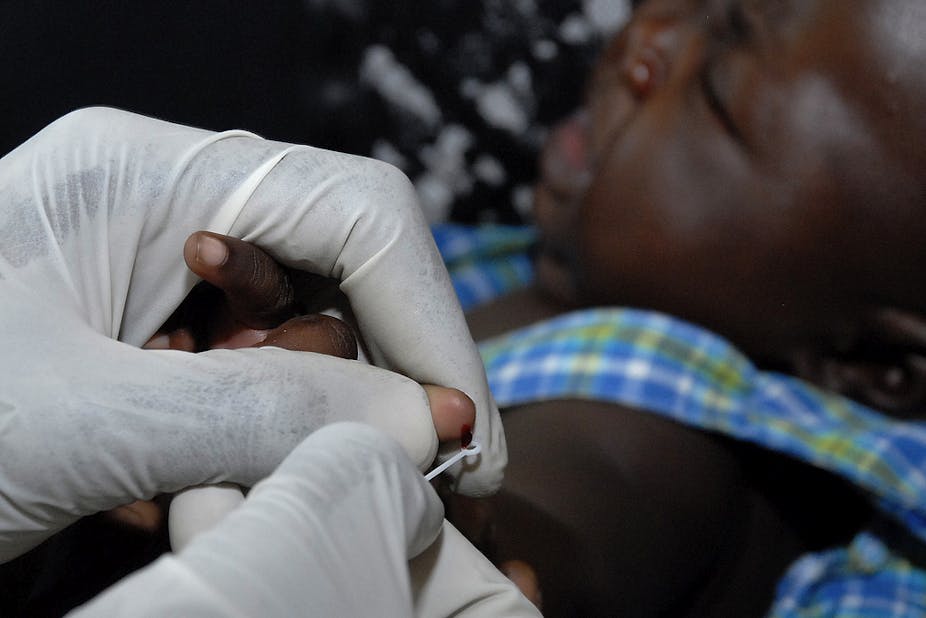The great burden of death and disease caused by the malaria parasite often goes unnoticed in the developed world. But it’s the leading cause of death in children under five years old in many sub-Sahara Africa countries, and its impact on the economic development of many more nations is crippling.
Development of a vaccine is high on the agenda of global health agencies, but despite more than 30 years of intensive research, no anti-parasite vaccine is available.
Professor Alan Cowman and his team (of which I am a part) have been studying the behaviour of the most lethal malaria parasite, Plasmodium falciparum, in human red blood cells for the last ten years. The central theme of this research is understanding the manner in which these parasites recognise, attach to and get inside a host cell.
The parasite
Plasmodium parasites are intracellular pathogens, invading red blood cells that they ultimately destroy through their voracious feeding and reproductive cycle, which takes 48 hours in the human body.
For every single parasite that infects a red blood cell, between 12 and 32 daughter cells are released into the bloodstream. Unchecked, this cycle causes destruction of massive numbers of red blood cells as well as a decrease in the production of new cells, which are responsible for carrying oxygen around the body.
This can lead to anaemia, coma and, for more than one million African children every year, death. By understanding the parasite’s biology, we can gain insight into its weaknesses, which we can then hopefully exploit to stop it in its tracks.
The technology
Our team is trying to do this by developing technology to genetically modify the parasite – in effect, creating weaker strains of the disease. We also intend to determine how these changes affect the ability of the parasite to get into the blood cells they depend on for survival.
Genetic modification has revolutionised the study of malaria. And the application of new technology has allowed us to answer an old question: what’s the mechanism by which malaria parasites gain entry into their host cells?
To try to solve this conundrum, we came up with new strategies to combat the disease. By creating parasite types in which specific genes have been removed, the team tried to uncover the myriad ways the parasite evolves and solve the essential problem of host-cell invasion.
The picture turned out to be a lot more complicated than we first thought.
Uncovering tracks to vaccine candidates
Initially, we were somewhat surprised that we could knock out a key invasion gene in the parasite with little effect on its ability to invade and multiply in the blood. But on closer examination we realised the mutant parasite had changed its behaviour, and was using a new, previously undiscovered, route of entry into the blood cell.
This finding led to the discovery of a number of new parasite molecules, which can act as vaccine candidates.
An effective vaccine against malaria needs to provoke a response that inhibits a process essential to the survival of the parasite. In the bloodstream, the malaria parasite hides from the immune system for the vast majority of time. But once the resources of a host cell are used up, the pathogen has to move on to a fresh haven. So the parasite ruptures the expired cell and becomes extracellular, before settling in a new host cell.
In the few minutes it spends between cells, the parasite is at its most susceptible to attack from the host. The antigens present on the surface of the parasite and those involved in red blood cell invasion can be targeted during this short extracellular phase to stop the growth of parasites in the blood.
Learning from natural immunity
It’s known that immunity to these antigens develops over time in malaria-infected children and that this is associated with protection from disease. Over time, if they survive the disease, infected children develop immunity to the invading parasites. But the time between infancy and immunity can be long, and punctuated by periods of terrible disease.
Nonetheless, that this natural state of immunity can be achieved provides hope that a vaccine targeting these proteins will provide vulnerable children with protection against malarial disease.
The benefits of a malaria vaccine are obvious. The question that remains is, what are the best candidates to pursue in order to hit the parasite hardest?
Based on our discovery of the multiple parasite ligands (molecules that bind to other – usually larger – molecules) involved in red blood cell invasion, it’s become clear that the vaccine of a single protein antigen wouldn’t work because the malaria parasite has a number of back-up pathways that can come into effect once one is blocked.
Our research has shown that certain parasite molecules work in combination with each other during invasion, whereas others mediate distinct invasion pathways, some of which come into effect as others are blocked.
There appears to be a type of molecular hierarchy at play during invasion, with different strains of the parasite preferring certain pathways over others. Our team has identified regions within these proteins that generate antibodies with the capacity to profoundly inhibit red blood cell invasion.
We believe that vaccinating individuals with a combination of proteins, each one representative of a different invasion pathway, is the way forward and are forging ahead with new international collaborations to produce a vaccine for clinical trials.

